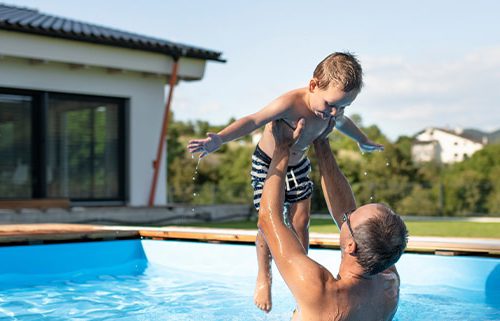 Home is where we feel safest, but often, we unwittingly take risks because of that sense of security. That’s especially apparent when it comes to drowning. Did you know that young children between the ages of one to four most often drown in home swimming pools? Needless to say, teaching your child water safety at home is critical.
Home is where we feel safest, but often, we unwittingly take risks because of that sense of security. That’s especially apparent when it comes to drowning. Did you know that young children between the ages of one to four most often drown in home swimming pools? Needless to say, teaching your child water safety at home is critical.
It’s not only young children we need to be concerned about, though. Drowning remains a leading cause of death for children as they age. However, older children more often drown in natural bodies of water. Any water, from bathtubs to oceans, can present a danger to children. Here are some things your children should know. Bear Paddle swimming lessons will enable kids to develop respect for the water while being safe.
Never Go Near Water Without An Adult
It’s important to teach children from a young age that water presents a danger, and an adult should always be supervising when they are near water. However, it’s also important for adults to remember that young children, especially, have not developed good impulse control.
Water that is less than two-inches deep poses a drowning risk to young children, so they should always be supervised. Birdbaths, fish ponds, ditches, and even toilets and sinks hold enough water that young children can drown in them. An adult should always be close enough to touch a young child or weak swimmer whenever they are in or near water.
Don’t Swim Alone
This is particularly important for older children. Even when we think our children are competent swimmers, we need to remember that accidents happen. Your star swimmer could slip on the wet deck of the pool, hit his head, and fall into the water unconscious. That’s why it’s so important never to swim alone (even for adults!).
Teach children that they must always ask for permission to go in or near water, and an adult should always be present. Even so, it’s a good idea to establish early on that your child always needs a buddy when swimming.
While you should do your best to ensure there will be adult supervision any time your child is swimming at a friend’s house, pool party, etc., if you’re not there, you cannot guarantee the level of supervision your child will receive. Stress that it’s essential to swim with a buddy so that if either child gets into trouble in the water, the other can go for help.
Wear Life Jackets On The Water
Sadly, tragic drownings happen every year when people don’t wear life jackets while boating, jet skiing, etc. Some people may find them uncomfortable to wear for hours on a boating trip or simply think they are good enough swimmers that they won’t need them. Some become complacent and don’t see drowning or capsizing as a real possibility. And sometimes, those who attempt to rescue people who are in the water without life jackets drown, as well.
If your children will be on the water in any capacity, whether it’s a ferry ride, a fishing boat, canoeing at camp, or riding jet skis, they need to wear life jackets. And it’s important for adults to model this behavior by wearing their own life jackets, too. Remember that it’s easy for children to be pulled under the water or become exhausted, no matter how proficiently they swim.
Finally, keep in mind that adults should always be responsible for keeping children safe. If you have a home pool, make sure that you have barriers, like fencing and covers, and keep them secure at all times. Even wading pools should be emptied and stored upside down. Model good habits and teach your children that we can all enjoy the water, as long as we keep our safety rules in mind.
